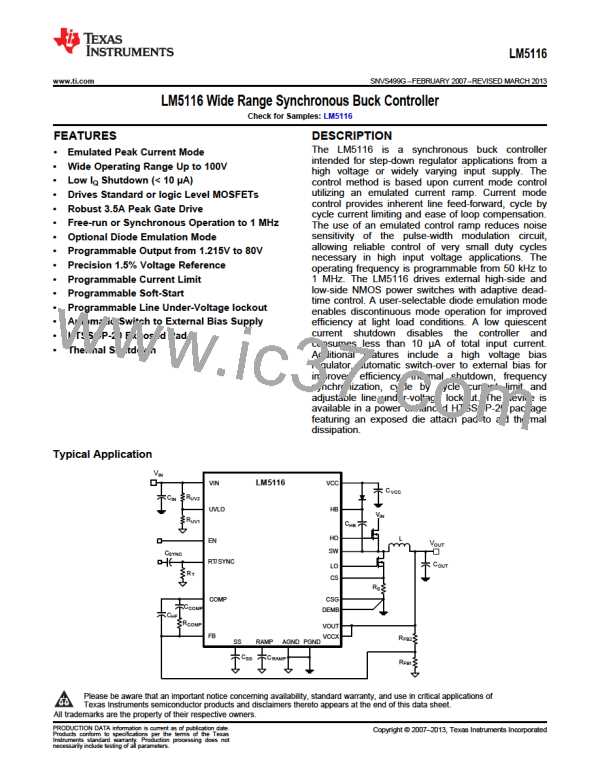LM5116
www.ti.com
SNVS499G –FEBRUARY 2007–REVISED MARCH 2013
comparator. If an overshoot should occur, the sample-and-hold circuit will detect the excess recirculating current.
If the sample-and-hold DC level exceeds the internal current limit threshold, the buck switch will be disabled and
skip pulses until the current has decayed below the current limit threshold. This approach prevents current
runaway conditions due to propagation delays or inductor saturation since the inductor current is forced to decay
following any current overshoot.
CURRENT SENSE
AMPLIFIER
CURRENT LIMIT
COMPARATOR
1.6V
10k
CS
1k
R
G
LO
-
+
-
-
R
I
L
S
+
+
gm x (VIN - VOUT) + 25 mA
1k CSG
R
G
10k
0.5V
10k
1k + R
HO
A =
RAMP
G
C
RAMP
Figure 33. Current Limit and Ramp Circuit
Using a current sense resistor in the source of the low-side MOSFET provides superior current limit accuracy
compared to RDS(ON) sensing. RDS(ON) sensing is far less accurate due to the large variation of MOSFET RDS(ON)
with temperature and part-to-part variation. The CS and CSG pins should be Kelvin connected to the current
sense resistor or MOSFET drain and source.
The peak current which triggers the current limit comparator is:
x tON
CRAMP
A x RS
25 mA
-
1.1V
1.1V
A x RS
IPEAK
=
,
where
•
tON is the on-time of the high-side MOSFET
(5)
The 1.1V threshold is the difference between the 1.6V reference at the current limit comparator and the 0.5V
offset at the current sense amplifier. This offset at the current sense amplifier allows the inductor ripple current to
go negative by 0.5V / (A x RS) when running full synchronous operation.
Current limit hysteresis prevents chatter around the threshold when VCCX is powered from VOUT. When 4.5V <
VCC < 5.8V, the 1.6V reference is increased to 1.72V. The peak current which triggers the current limit
comparator becomes:
x tON
CRAMP
A x RS
25 mA
-
1.22V
1.22V
A x RS
IPEAK
=
,
(6)
This has the effect of a 10% fold-back of the peak current during a short circuit when VCCX is powered from a
5V output.
Soft-Start and Diode Emulation
The soft-start feature allows the regulator to gradually reach the initial steady state operating point, thus reducing
start-up stresses and surges. The LM5116 will regulate the FB pin to the SS pin voltage or the internal 1.215V
reference, whichever is lower. At the beginning of the soft-start sequence when SS = 0V, the internal 10 µA soft-
start current source gradually increases the voltage of an external soft-start capacitor (CSS) connected to the SS
pin resulting in a gradual rise of FB and the output voltage.
Copyright © 2007–2013, Texas Instruments Incorporated
Submit Documentation Feedback
17
Product Folder Links: LM5116

 TI [ TEXAS INSTRUMENTS ]
TI [ TEXAS INSTRUMENTS ]